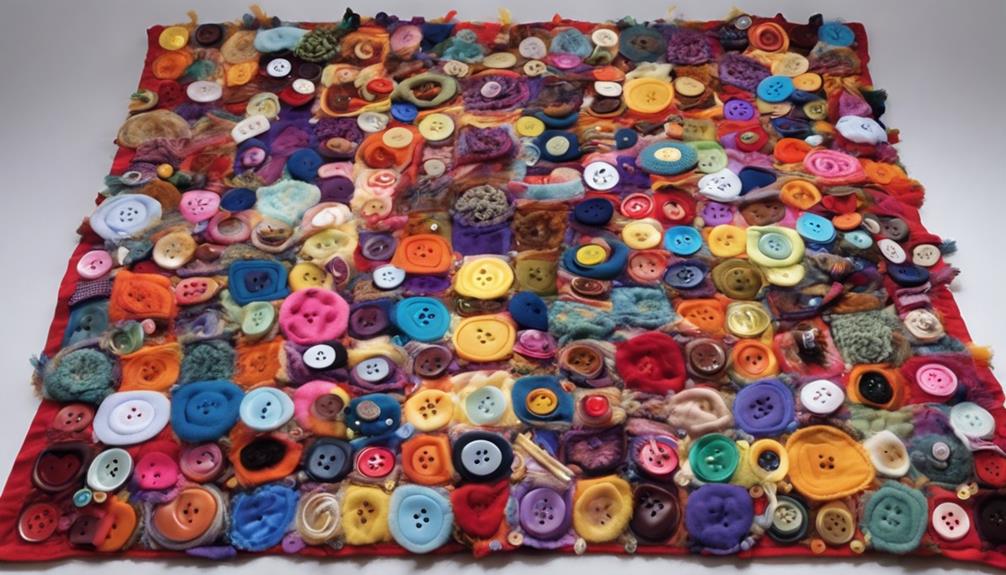Just like a light breeze on a sunny day, the idea of a Dementia Fidget Blanket provides a feeling of comfort and interaction for those facing memory difficulties.
However, the true impact and benefits of this innovative tool go beyond mere tactile sensations. As we explore the intricate design and thoughtful features of these blankets, we uncover a realm where memories are sparked, emotions are kindled, and connections are rekindled.
The journey through the realm of Dementia Fidget Blankets promises a deeper understanding of the profound impact such a simple yet powerful tool can have on those navigating the complexities of dementia.
Benefits of Dementia Fidget Blankets
Dementia fidget blankets offer a myriad of benefits for individuals with cognitive issues, providing essential sensory stimulation and emotional support. These blankets are designed to engage individuals in sensory activities, which can be particularly helpful for those with dementia. The various textures, fabrics, and attachments on the blankets help stimulate the senses, improving focus, attention, and motor skills in a gentle and comforting manner.
Engaging with dementia fidget blankets can have a calming and soothing effect, reducing stress and anxiety for users. The sensory activities provided by these blankets offer individuals a sense of security and distraction, which can be especially beneficial for adults with cognitive challenges. By incorporating these sensory activities into daily routines, individuals with dementia can experience enhanced emotional support and overall well-being.
In addition to benefiting individuals with dementia, these fidget blankets are also valuable dementia products for the elderly, as they cater to specific sensory needs and conditions, ultimately improving the quality of life for users.
How to Choose a Fidget Blanket

When selecting a fidget blanket for someone with cognitive challenges, it's crucial to carefully assess the sensory elements and activities that will best engage and support their needs. Consider the textures, fabrics, and attachments that will provide sensory stimulation and comfort to the individual with dementia.
Look for fidget blankets that offer activities matching their cognitive abilities and interests, promoting memory recall and emotional connections. Ensure the fidget blanket has safe features such as securely attached elements and no loose parts that could pose a choking hazard.
Opt for a blanket that provides a variety of activities to keep the person engaged and stimulated. By choosing a fidget blanket thoughtfully, you can offer a source of comfort and engagement for individuals with dementia, enhancing their quality of life through tactile experiences and sensory engagement.
DIY Fidget Blanket Ideas
Exploring DIY fidget blanket ideas allows for a personalized touch with sensory elements like buttons, zippers, and textures. When creating these blankets, using leftover wool, fabric pieces, and stabilizer can ensure durability. The assembly process involves sewing, turning the fabric inside out, ironing for stability, and final stitching. It's important to securely attach items like soft toys to guarantee safety and maintain interest. Personalizing the fidget blankets based on individual preferences is key; consider adding ribbons for an apron conversion or incorporating supervision reminders for added safety.
In the realm of dementia care, these DIY fidget blankets can serve as engaging activities that cater to sensory needs. The process of making these blankets not only provides a creative outlet but also results in a personalized item that can bring comfort and stimulation. By incorporating various textures and interactive elements, these blankets become valuable tools for individuals with dementia, offering both tactile experiences and a sense of familiarity. The act of crafting these blankets with love and attention to detail can truly make a difference in enhancing the quality of life for those living with dementia.
Using Fidget Blankets for Therapy

Crafting fidget blankets for therapy involves selecting materials and textures that provide sensory stimulation and engagement for individuals with dementia, promoting emotional support and enhancing their overall well-being. When creating fidget blankets for therapy, it's essential to consider the specific needs and preferences of dementia patients to ensure the effectiveness of the therapeutic tool.
Here are three key aspects to focus on:
- Sensory Stimulation: Incorporating a variety of textures such as soft fabrics, smooth surfaces, and different tactile elements can help stimulate the senses of dementia patients, keeping them engaged and improving their cognitive functions.
- Emotional Support: By including comforting materials like plush fabrics or familiar items, fidget blankets can offer emotional support to individuals with memory loss, providing them with a sense of security and familiarity.
- Therapeutic Engagement: Utilizing interactive features such as buttons, zippers, and beads can enhance the therapeutic benefits of fidget blankets, encouraging fine motor skills development and cognitive engagement in dementia patients.
Caregiver Tips for Fidget Blankets
How can caregivers best enhance the experience of individuals with dementia using fidget blankets?
Caregivers play a crucial role in maximizing the benefits of fidget blankets for individuals with dementia. When selecting or creating a fidget blanket, consider the individual's preferences and needs. Ensure the fidget blanket offers a variety of textures, colors, and attachments to promote sensory stimulation. Remove any small or loose items that could pose a choking hazard. Engage with the individual while they use the fidget blanket to create a meaningful connection and enhance the overall experience.
Fidget blankets are versatile tools that can be used to promote motor skills, memory recall, and emotional bonds. Caregivers should encourage individuals at different stages of dementia to interact with the fidget blanket in ways that are comfortable and enjoyable for them. By leaving the fidget blanket in accessible areas, individuals can engage with it spontaneously, providing comfort and stimulation throughout the day.
Caregivers' thoughtful approach to incorporating fidget blankets into daily care routines can greatly benefit individuals with dementia.
Frequently Asked Questions
Do Fidget Blankets Work for Dementia Patients?
Fidget blankets can be effective tools for providing sensory stimulation and engagement for individuals with dementia. They offer emotional support, security, and distraction, helping to soothe, calm, and engage those with cognitive challenges.
The effectiveness of fidget blankets varies based on individual needs, making them a valuable resource for individuals requiring specific sensory support. These blankets serve as a comforting and therapeutic aid for those dealing with dementia.
What Are 3 Things to Never Do With Your Loved One With Dementia?
When caring for a loved one with dementia, it's essential to never overlook their emotional well-being, physical safety, and autonomy. Never dismiss their feelings or force them to do something that causes distress. Avoid neglecting their physical needs or ignoring any signs of discomfort.
Never underestimate the importance of their dignity and independence as you provide care and support. Always prioritize their well-being above all else.
What Stage of Dementia Is Sundowning?
Sundowning typically occurs in the middle to late stages of dementia, like Alzheimer's disease. It's characterized by increased confusion, agitation, and restlessness, worsening in the late afternoon or evening. Environmental factors can trigger or worsen these symptoms.
Managing sundowning may involve establishing a calming routine, reducing stimulation, and promoting relaxation. It's crucial to provide support and understanding during this challenging time for both individuals with dementia and their caregivers.
What Is the Number One Trigger for Dementia Behavior?
In our experience, the number one trigger for dementia behavior is often linked to environmental factors and changes. Sudden disruptions in routine or unfamiliar surroundings can lead to challenging behaviors in dementia patients.
Overstimulation from noise, crowds, or bright lights can trigger agitation and confusion. Lack of proper communication or understanding of needs can also escalate behavioral issues.
Identifying triggers and providing a calm, structured environment is crucial to minimizing challenging behaviors in those with dementia.
Conclusion
In conclusion, dementia fidget blankets are powerful tools for providing comfort and engagement for individuals living with dementia.
Like a gentle embrace from a loved one, these blankets offer a sense of familiarity and security in a world that can often feel confusing and overwhelming.
By incorporating sensory activities and personalized touches, fidget blankets can bring joy and connection to those facing the challenges of dementia.










